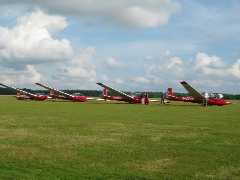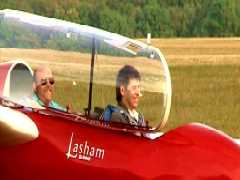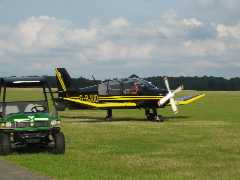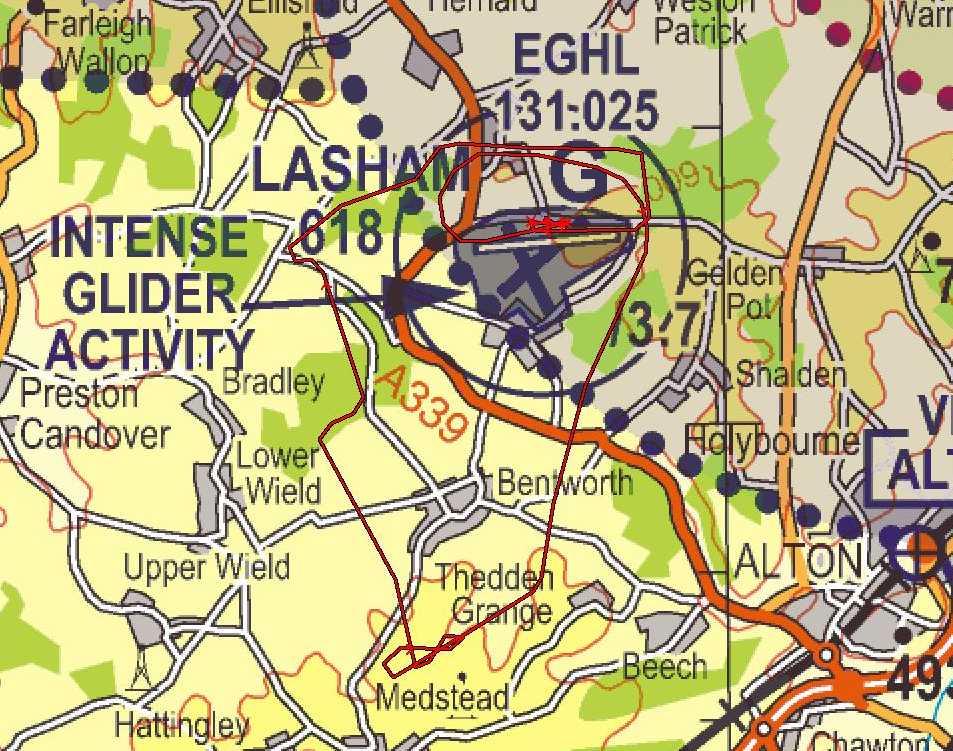Date: 26/6/2009
Time: 18:55 - 19:10
Aircraft: K13 Glider - G-CFHM
Gliding
OK, not microlighting, but flying all the same.
My boss Vic is the chairman of the North Hants
Jaguar Enthusiasts Club who were having an evening social at Lasham Gliding
Club to have a go at gliding. As he is a bit big to fly himself, he kindly invited
me to come along and have a go.
 We
turn up at 5:30 pm and after paperwork and the safety brief, we are eventually
out to the airfield. We have a bit of a lottery to select the order and with
my usual luck, I'm second to last - not a problem though, as there's plenty
of time. I watch the other on their way with varying degrees of intrepidation.
We
turn up at 5:30 pm and after paperwork and the safety brief, we are eventually
out to the airfield. We have a bit of a lottery to select the order and with
my usual luck, I'm second to last - not a problem though, as there's plenty
of time. I watch the other on their way with varying degrees of intrepidation.
 Eventually
it's my turn. First, I have to put a parachute on and have to squat down whilst
tightening the straps. This makes standing up quite difficult, but fortunately
once in the aircraft, I am sitting down so it isn't uncomfortable. My instructor,
Merv is sat behind me. The first weird thing, as the canopy is closed, is the
lack of headset - I can hear Merv OK, but do find myself leaning back a bit
to hear better. The tug aircraft is attached by the tow-rope and an assistant
holds one wing so we are level. The tug then opens it's throttle and we're off
- surprisingly smoothly.
Eventually
it's my turn. First, I have to put a parachute on and have to squat down whilst
tightening the straps. This makes standing up quite difficult, but fortunately
once in the aircraft, I am sitting down so it isn't uncomfortable. My instructor,
Merv is sat behind me. The first weird thing, as the canopy is closed, is the
lack of headset - I can hear Merv OK, but do find myself leaning back a bit
to hear better. The tug aircraft is attached by the tow-rope and an assistant
holds one wing so we are level. The tug then opens it's throttle and we're off
- surprisingly smoothly.
Merv flies the initial bit behind the tug which
is probably for safety. He asks me if I have done this before - "haven't
done gliding before " I replied, "but I do fly a microlight".
"Ooh - Flexwing or three-axis", he inquired. He was pleased to hear
it's three-axis as some flexwing pilots push the stick the wrong way. We climb
at about 65 knots up to 2500' above the airfield level and then disengage from
the tug with a slight clunk.
 Once
free, we then slow down the normal gliding speed of about 45 knots and it's
my turn to have a go flying. We try a few exploratory turns - it seems to need
a lot more rudder to balance the turns, than the C-42 and also more stick movement
in general. However, the controls are all light - though it does make it a little
difficult to detect if you have the rudder centralised. I also miss the balance
ball. We then head towards the north with more turns practice and then I ask
what the stall speed is - Merv invite me to try, and it appears to be around
36 knots, but it does let you know that it's about to happen. Once north of
the runway, head east. Merv then suggests another turn to the north, which seems
odd to me as at 800' we are in my normal downwind approach. But soon enough,
we are downwind and then turn base. Another odd thing is that in a powered aircraft
we slow down for approach, but in this glider we speed UP to 55 knots - presumably
for safety.
Once
free, we then slow down the normal gliding speed of about 45 knots and it's
my turn to have a go flying. We try a few exploratory turns - it seems to need
a lot more rudder to balance the turns, than the C-42 and also more stick movement
in general. However, the controls are all light - though it does make it a little
difficult to detect if you have the rudder centralised. I also miss the balance
ball. We then head towards the north with more turns practice and then I ask
what the stall speed is - Merv invite me to try, and it appears to be around
36 knots, but it does let you know that it's about to happen. Once north of
the runway, head east. Merv then suggests another turn to the north, which seems
odd to me as at 800' we are in my normal downwind approach. But soon enough,
we are downwind and then turn base. Another odd thing is that in a powered aircraft
we slow down for approach, but in this glider we speed UP to 55 knots - presumably
for safety.
We turn final and I'm told to use the airbrake -
too much at first, as we have to land long to finish up near the hanger. Quite
a lot of rudder required to keep it straight and then back on the stick to round
out, still we some airbrake, and then we touch-down. Whilst rumbling along,
Merv announces that he has control, and points us toward the hanger and stops
just before the tarmac. We then get out. I ask Merv how much of the landing
he did, to which he replied nothing, until he said he had control. So it seems
I landed it all on my own (of course whilst being told what to do). The airbrakes
do make it easier.
I help put the glider back in its hanger and we
put the parachutes away. We have some dinner (chile) with Vic and some other
Jag club members in their cafe and a general chat. Later, Merv comes and finds
me to give me my certificate - he reckons that I did well, and wouldn't take
long to convert onto gliders. Not this year!

Return to 2009 Index
Return to main Index
 We
turn up at 5:30 pm and after paperwork and the safety brief, we are eventually
out to the airfield. We have a bit of a lottery to select the order and with
my usual luck, I'm second to last - not a problem though, as there's plenty
of time. I watch the other on their way with varying degrees of intrepidation.
We
turn up at 5:30 pm and after paperwork and the safety brief, we are eventually
out to the airfield. We have a bit of a lottery to select the order and with
my usual luck, I'm second to last - not a problem though, as there's plenty
of time. I watch the other on their way with varying degrees of intrepidation.
